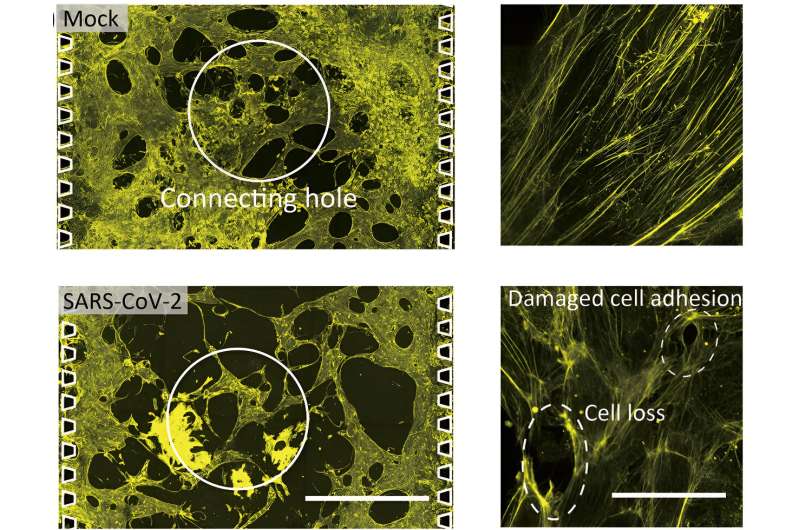This article has been reviewed according to Science X's editorial process and policies. Editors have highlighted the following attributes while ensuring the content's credibility:
fact-checked
trusted source
proofread
A microscopic multi-organ model to study bronchi-vasculature interactions during SARS-CoV-2 infections

A recent collaborative study has developed a microphysiological system to study the effects of COVID-19. The model consists of bronchial organoids and vascular beds and reveals the interactions between the bronchi and vasculature upon SARS-CoV-2 infection. The researchers also identified novel targets to minimize blood vessel damage, a hallmark feature of severe COVID-19 cases. The study is published in the journal Lab on a Chip.
Aside from its detrimental effects on the respiratory system, SAR-CoV-2 infection, especially in severe COVID-19 cases, dramatically impacts multiple organ systems, including the vasculature. The loss of blood vessel structural integrity and function has been a major focus of research efforts to understand the pathophysiology of COVID-19, but in vitro studies to date using only vascular epithelial cells to model SAR-CoV-2 infection have provided conflicting evidence.
The research team thus attempted a comprehensive examination by recapitulating the inter-organ interactions between the bronchi and blood vessels using a microphysiological system built by co-culturing primary bronchial epithelial cells (as bronchial organoids) and endothelial cells (as a vascular bed) on a device with microfluidic devices.
The researchers found ACE2 and TMPRSS2, the principal receptor and protease, respectively, SAR-CoV-2 hijack for cell entry, to be principally expressed in bronchial organoids. Consequently, they also observed viral infection to occur predominantly in the bronchial epithelial cells, while the vascular bed was uninfected initially.
However, despite viral infection and replication taking place primarily in the bronchial tissue of the microphysiological system, gene expression analysis at 4 days following viral infection revealed that both tissue types had developed inflammatory responses over time. Further morphological analysis of both tissues revealed structural and functional disruptions to the vascular bed, paralleling the vascular damages observed in tissue samples from COVID-19 patients.
Notably, the researchers found genetic deletions of a receptor critical for interferon signaling (IFNAR2 ) from the endothelial cells or interferon beta (IFNB1 ) from the bronchial organoids to exert significant protective effects against the vascular damages caused by SAR-CoV-2 infection.
Conversely, the research team observed similar protective effects by treating the microphysiological systems with chemical inhibitors of the JAK/STAT pathway, a major downstream cell signaling pathway activated by interferons. Thus, these findings together indicate that viral infection of the bronchial epithelium induces an inflammatory response, which in turn causes substantial tissue damage to the connected vascular bed via interferon signaling.
In this study, the researchers demonstrated the capability of such microphysiological systems to recapitulate inter-organ interactions to vastly improve our understanding of pathophysiological mechanisms and explore potential treatments.
The research was led by Junior Associate Professor Kazuo Takayama (Department of Cell Growth and Differentiation, CiRA, Kyoto University) and Professor Ryuji Yokokawa (Department of Micro Engineering, Graduate School of Engineering, Kyoto University).
The researchers hope that future developments of this technology, for example, incorporating immune cells and other cell types, can model in vivo conditions even more accurately to reveal the intricate molecular details that may help to prevent tissue damage to the vasculature and other organ systems as a result of infection by SARS-CoV-2 and other respiratory viruses.
More information: Kazuya Fujimoto et al, SARS-CoV-2-induced disruption of a vascular bed in a microphysiological system caused by type-I interferon from bronchial organoids, Lab on a Chip (2024). DOI: 10.1039/D3LC00768E





















